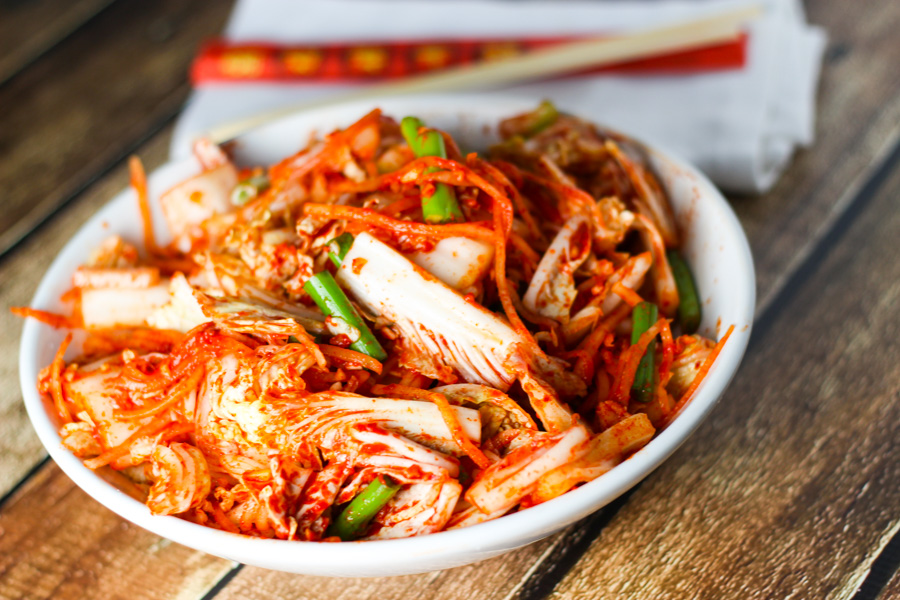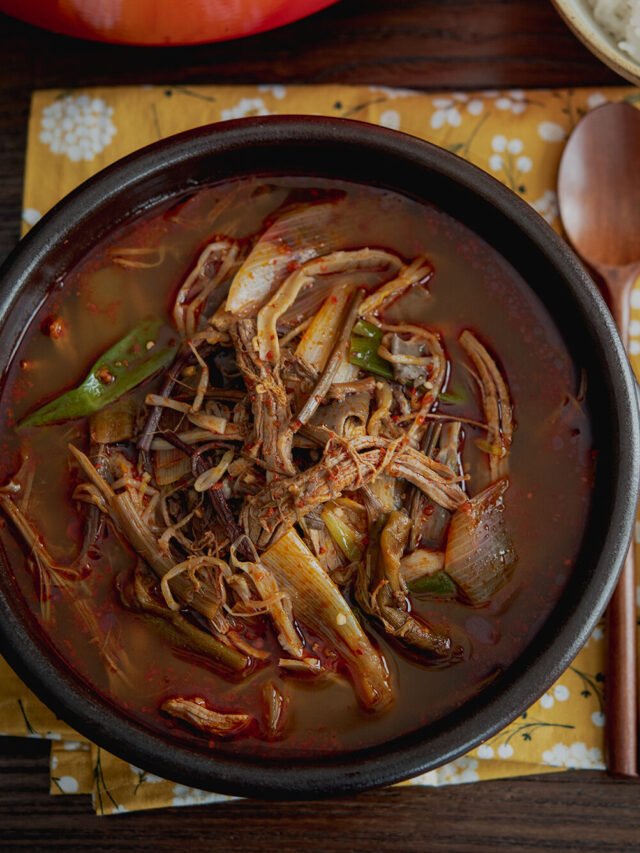Kimchi is a traditional Korean dish made from fermented vegetables, most commonly napa cabbage and Korean radishes, with a variety of seasonings. It’s a staple in Korean cuisine, known for its spicy, tangy, and umami-rich flavor. Making kimchi at home can be a fun and rewarding process, and it allows you to adjust the ingredients to suit your taste. Here’s a detailed guide on how to make authentic Korean kimchi.
Ingredients
For the cabbage:
- 1 large napa cabbage (about 2 kg or 4.5 lbs)
- 1/2 cup sea salt or kosher salt
- 5 cups water
For the seasoning paste:
- 1 cup Korean red pepper flakes (gochugaru)
- 1/4 cup fish sauce
- 1/4 cup salted shrimp (Daejeon), finely chopped
- 1/4 cup water
- 1 tablespoon sugar
- 1 tablespoon grated ginger
- 5-6 cloves garlic, minced
- 1 medium onion, finely chopped
- 4 green onions, chopped into 1-inch pieces
- 1 Korean radish (mu), julienned (about 1 cup)
- 1 carrot, julienned (optional)
Optional additional ingredients:

- 1 apple or Asian pear, peeled and grated
- 2 tablespoons soy sauce (for a vegetarian version, replace fish sauce and salted shrimp)
Instructions
Step 1: Preparing the Cabbage
- Cut the cabbage: Trim the ends of the napa cabbage and cut it lengthwise into quarters. Then cut each quarter into 2-inch wide strips.
- Salt the cabbage: Dissolve 1/2 cup of salt in 5 cups of water. In a large bowl, layer the cabbage pieces, sprinkling each layer generously with the saltwater. Ensure the cabbage is well-coated with salt. Let it sit for about 2 hours, turning the cabbage occasionally to ensure even salting.
- Rinse and drain: After 2 hours, rinse the cabbage thoroughly under cold running water to remove the excess salt. Repeat this process 2-3 times. Drain well and let it sit in a colander for 30 minutes to remove excess water.
Step 2: Making the Seasoning Paste
- Prepare the base: In a small bowl, combine the Korean red pepper flakes (gochugaru), fish sauce, salted shrimp, water, and sugar. Mix well until it forms a paste. Adjust the amount of gochugaru based on your heat preference.
- Add aromatics: To the paste, add the grated ginger, minced garlic, and finely chopped onion. Mix thoroughly.
- Incorporate vegetables: Add the green onions, julienned radish, and optional carrot to the paste. If using, also add the grated apple or pear. Mix everything together until the vegetables are well-coated with the seasoning paste.

Step 3: Combining Cabbage and Seasoning
- Mix the kimchi: Wearing food-safe gloves (to protect your hands from the chili), take a handful of the seasoning paste and rub it onto the cabbage pieces. Ensure each piece of cabbage is well-coated with the paste.
- Pack the kimchi: Pack the coated cabbage tightly into a clean, dry glass jar or an airtight container. Press down to remove any air pockets. Leave some space at the top of the jar as the kimchi will expand as it ferments.
Step 4: Fermentation
- Initial fermentation: Leave the jar at room temperature for about 1-2 days to begin the fermentation process. The exact time will depend on the room temperature – it ferments faster in warmer temperatures.
- Check for readiness: After 1-2 days, open the jar to check the kimchi. You should see bubbles forming and it should have a tangy smell. If you prefer a more fermented flavor, leave it out for another day.
- Refrigeration: Once the kimchi has reached your desired level of fermentation, transfer it to the refrigerator. This slows down the fermentation process. Kimchi can be eaten immediately but it tastes best after at least a week in the refrigerator as the flavors continue to develop.
Step 5: Serving and Storage
- Serve: Kimchi can be enjoyed on its own or as a side dish to various Korean meals. It’s a versatile ingredient that can be used in soups, stews, stir-fries, and even in savory pancakes.
- Storage: Properly stored in the refrigerator, kimchi can last for several months. The flavor will continue to develop over time, becoming more sour and complex.
Tips for Making the Best Kimchi
- Quality ingredients: Use fresh and high-quality ingredients for the best results. Napa cabbage and Korean radish are essential for authentic flavor.
- Salt: Be sure to use sea salt or kosher salt without iodine, as iodized salt can affect the fermentation process.
- Adjust seasoning: Feel free to adjust the amount of gochugaru (Korean red pepper flakes) according to your spice tolerance. You can also modify the amount of garlic and ginger to suit your taste.
- Fermentation time: The fermentation time can vary depending on the temperature and your personal preference. Warmer temperatures speed up fermentation, while cooler temperatures slow it down. Taste your kimchi daily to decide when it’s perfect for you.
- Using other vegetables: You can add other vegetables to your kimchi such as cucumbers, scallions, and even fruits like apples or pears for a sweeter flavor.

Health Benefits of Kimchi
Kimchi is not only delicious but also packed with health benefits:
- Probiotics: Fermented foods like kimchi are rich in probiotics, which promote a healthy gut microbiome and improve digestion.
- Vitamins and Minerals: Kimchi is a great source of vitamins A, B, and C, and minerals like calcium and iron, which are essential for overall health.
- Antioxidants: The ingredients in kimchi, such as garlic, ginger, and chili peppers, contain antioxidants that help reduce inflammation and boost the immune system.
- Low in Calories: Kimchi is low in calories but high in fiber, making it a great addition to a balanced diet.
Cultural Significance
Kimchi is more than just a dish; it is a cultural icon in Korea. It’s a symbol of Korean identity and heritage. The process of making kimchi, known as kimjang, is an important cultural activity in Korea, often involving the whole family or community. In 2013, UNESCO recognized kimjang as an Intangible Cultural Heritage of Humanity, highlighting its importance in Korean culture.
Conclusion
Making homemade Korean kimchi is a rewarding process that allows you to connect with Korean culinary traditions. By following this detailed guide, you can create your own delicious and authentic kimchi at home. Enjoy the unique flavors and health benefits that come with this traditional fermented dish. Happy fermenting!















